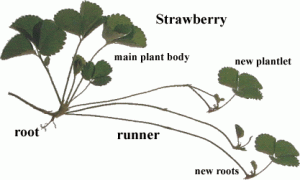 There’s a rumor going around, “that Caesandra is stealing plants from the ReUse Gardens.”
There’s a rumor going around, “that Caesandra is stealing plants from the ReUse Gardens.”
Well, that’s only partially true. Friday morning, I ran into board member, Keith James, as I was removing runners from the overgrown strawberry mound in the Children’s Vinery.
I explained to Keith that the original strawberry plants–known as “mother plants” were in their 3rd year of growth. This means, their strawberry yield will start to diminish. The plants suffered a lot of trauma over the winter by not being mulched with straw or leaves. The runners also taxed the mother plants to the point where there were a lot of leaves, but few flowers/fruit this past season.
The runners draw energy from the mother plant and even send out runners of their own. These runners do put down roots and eventually make a new strawberry plant which can also bear fruit.
However, in the case of the strawberry mound in the Children’s Vinery, the runners spread out into the walking path and into soil that was not of the same quality or depth. Those new plants should be pulled and relocated because they won’t produce very good fruit. Runners continue to grow all summer and you have to continue to cut them. Last summer I taught several workshops about strawberries and gave away the runners to folks that attended the workshops.
Friday morning I also spent a few minutes cutting the scapes off the garlic we planted last fall. If you do not remove scapes–the garlic clove will grow you a beautiful flower, and only some small garlic bulbs for cooking! Cutting the scape sends the energy back down into the clove, causing it to expand and produce a big fat head of garlic, which you can throw in your pan with tomatoes and onions or rub on bread or slather your neck to deter blood suckers.
Later, Keith brought over about a dozen volunteers from Sacred Heart who were going to weed the Children’s Vinery. Keith asked me to give them some pointers. I recommended some tools and showed the young ladies the difference between the strawberry plant leaves and invasive knotweed so they could identify the problem plants. Many people compost weeds because the heat eventually breaks down the plant parts and seeds. I cautioned the volunteers to keep the knotweed plant parts separate from the other weeds and to make sure not to put knotweed into the compost pile because it will re-root and spread. I also pointed out many of the plants that aren’t currently blooming, but shouldn’t be pulled because they’re perennials.
If you would like your strawberry plants to continue producing the MOST amount of berries for you each year, you should remember the following maintenance:
1. Cut the runners–throw them out or give them to friends or transplant them elsewhere in your garden.
2. Strawberry plants like a little dappled shade
3. Bundle straw around the crown and under the leaves so that your berries are kept them off the damp ground.
4. Slugs are snails with no shell. They like strawberries as much as you and me–make sure you check the berry for holes before you pop it in your mouth or you will eat the slug that is eating the berry from the inside OUT (ewww).
4.5 Slugs also like beer as much as you and me, but the salt in beer will kill/drown them. Set out little shallow plates or yogurt cups with beer and it will help reduce your slug population.
5. In late October, trim back the leaves on the strawberry plants and bury the plants under no less than one-two feet of straw or FREE AUTUMN LEAVES! Remove the blanket of leaves in April.
